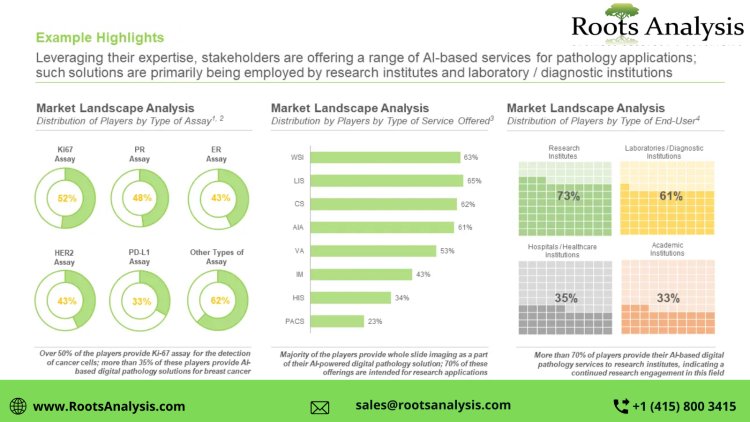AI-based digital pathology gains interest due to automation, digitization of healthcare
In recent years, advancements in technology and emphasis on precision medicine have recently paved the path for the development of artificial intelligence (AI) based digital pathology techniques for quantitative and qualitative assessment of samples.

Specifically, the process of AI-based digital pathology allows scanning of slides via computer monitors, by replacing the conventional microscopic approaches. Further, by converting glass slides to images, samples can be transmitted from diagnostic centers to pathologists within a fraction of time. Considering the rising popularity and demand for such solutions in the healthcare and research industry, and the ongoing efforts of AI-powered digital pathology solution providers / AI pathology solution providers to further improve / expand their respective portfolios, we believe that the AI-based digital pathology market / AI Pathology Market is likely to evolve at a steady pace, till 2035.
To request a sample copy / brochure of this report, please visit this
https://www.rootsanalysis.com/reports/ai-based-digital-pathology-market/request-sample.html
The steps involved in the usual workflow of AI-based digital pathology process.
- Preparation of Tissue Sample: This process is very similar to the conventional approach. A pathologist examines a biopsy to determine its color, size and consistency. At this point, the specialist can detect symptoms of malignancy and select which areas of a specimen should be inspected under the microscope. Further, the chosen region is prepared by following multi-step processes, such as treatment of the tissue with chemicals in order to maintain its structure, mounting the specimen on a glass slide, staining to improve contrast and protecting the tissue with coverslips.
- Converting into Virtual Sample / Whole slide imaging (WSI): WSI or virtual microscopy is a technique that is used to enable digital pathology. Its central component, which is a WSI scanner, captures a picture of the glass slide and generates a precise electronic replica known as a virtual slide. It is worth noting that virtual slides, unlike glass slides, are easy to replicate, save, categorize and distribute. Furthermore, they may be linked to electronic health records, thereby, providing a complete picture of a patient's health.
- Saving a Virtual Slide: The scanner pre-processes the virtual slide automatically and stores it to on-premises or cloud storage. In order to minimize the file size, a compression approach is frequently employed before saving the slide.
- Viewing and Editing of Slide: In the digital process, instead of using a traditional microscope, a pathologist uses a computer display to analyze enlarged tissue samples. A slide viewing and management software is used to zoom out a tissue segment and observe its smallest features. In addition, this software allows the pathologist to view the slide from different angles, add annotations and even compare multiple images at one time.
- Sharing Data: Using specialized digital pathology software applications, slides are converted to an electronic format, thereby, allowing them to be exchanged using the internet. These slides can be shared to gain a second opinion, as well as with patients, research facilities and other stakeholders.
- Reporting Results: Some image viewing systems provide reporting capabilities. However, this work is often accomplished by enabling interaction with the laboratory information or laboratory information management system (LIS/LIMS) and hospital information system (HIS).
The digital revolution of pathology is projected to accelerate in the coming years, considering multiple growth drivers, including growing number of laboratories adopting high throughput digital scanning and software technologies to assist diagnostic practice. In addition, factors, including shortage of skilled pathologists in remote areas, increasing pathology workloads due to ageing populations, higher rate of cancer screening programs, rising complexity of pathology testing and time constraints, and requirement for pathology labs to outsource expertise in the field, also contributes significantly towards the need for AI-based digital pathology solutions.
For additional details, please visit
https://www.rootsanalysis.com/reports/ai-based-digital-pathology-market.html or email sales@rootsanalysis.com
You may also be interested in the following titles:
- Smart Labels Market: Industry Trends and Global Forecasts, 2022-2035
- 4D Bioprinting Market : Industry Trends and Global Forecasts, 2022-2035
About Roots Analysis
Roots Analysis is a global leader in the pharma / biotech market research. Having worked with over 750 clients worldwide, including Fortune 500 companies, start-ups, academia, venture capitalists and strategic investors for more than a decade, we offer a highly analytical / data-driven perspective to a network of over 450,000 senior industry stakeholders looking for credible market insights.
Contact:
Ben Johnson
+1 (415) 800 3415
Ben.johnson@rootsanalysis.com


















































